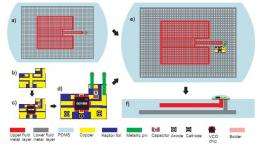uFSRFE: Stretchable electronics report how you feel

(PhysOrg.com) -- Electronics that can be bent and stretched might sound like science fiction. But Uppsala researcher Zhigang Wu, working with collaborators, has devised a wireless sensor that can stand to be stretched. For example, the sensor can measure intensive body movements and wirelessly send information directly to a computer. The findings are now being presented in the journal Advanced Functional Materials.
Robots of liquid metal, as in the Terminator movies, are probably the best-known cases of deformable electronic systems. But so far this only exists in our imagination. Twisting, folding, and stretching fragile conventional electronics is not yet possible.
The latest advances in the field of µFSRFE (microfluidic stretchable radio frequency electronics) have shown the possibility of combining established stiff electronics components with channels of elastomers filled with fluid metal. In this way it has been possible to construct systems that after severe mechanical deformation can manage to return to their original form. Such electronics can adapt to nearly any bent and moving surfaces on a human being or a robot and can thus serve as a second layer of smart e-skin for health monitoring or remote control.
The researcher Zhigang Wu from Uppsala University, in collaboration with researchers at the company Laird Technologies, has presented a newly developed and wireless µFSRFE sensor consisting of a multifunctional antenna integrated with a conventional rigid circuit board. The reporting sensor can measure intensive body movements and wirelessly send information directly to a computer. The design enables wireless measurement of repeated bending across a large area or moveable parts.
The sensor they designed will pave the way for myriad new applications that until now have only been seen on the movie screen.
More information: ”A Microfluidic, Reversibly Stretchable, Large-Area Wireless Strain Sensor”, Shi Cheng and Zhigang Wu, Advanced functional materials, DOI: 10.1002/adfm.201002508
Abstract
This article describes the implementation and characterization of a new self-contained large-area wireless strain sensor, operating around 1.5 GHz, based on the concept of multi-layer microfluidic stretchable radiofrequency electronics (μFSRFEs). Compared to existing solutions, the presented integrated strain sensor is capable of remotely detecting repeated high tensile dynamic strains of up to 15% over very large surfaces or movable parts, and gets rid of all hardwiring to external storage or data processing equipment. Unlike conventional electronic devices, the major part of the sensor is a mechanically reconfigurable and reversibly deformable patch antenna, which consists of two layers of liquid metal alloy filled microfluidic channels in a silicone elastomer. A simplified radiofrequency (RF) transmitter composed of miniaturized rigid active integrated circuits (ICs) associated with discrete passive components was assembled on a flexible printed circuit board (FPCB) and then heterogeneously integrated to the antenna. The elastic patch antenna can withstand repeated mechanical stretches while still maintaining its electrical function to some extent, and return to its original state after removal of the stress. Additionally, its electrical characteristics at frequency of operation are highly sensitive to mechanical strains. Consequently, not only is this antenna a radiator for transmitting and receiving RF signals like any other conventional antennas, but also acts as a reversible large-area strain sensor in the integrated device. Good electrical performance of the standalone antenna and the RF transmitter sub-module was respectively verified by experiments. Furthermore, a personal computer (PC)-assisted RF receiver for receiving and processing the measured data was also designed, implemented, and evaluated. In the real-life demonstration, the integrated strain sensor successfully monitored periodically repeated human body motion, and wirelessly transmitted the measured data to the custom-designed receiver at a distance of 5m in real-time.
Provided by Uppsala University


















